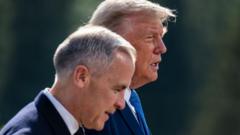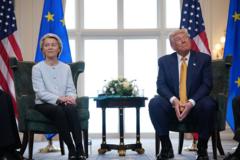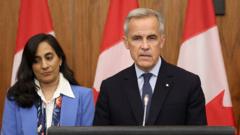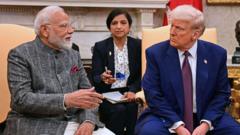After missing a critical deadline for a new trade deal, the US and Canada are reevaluating the prospects for their relationship amid ongoing tariffs. While pressure mounts on both sides, some experts believe Canada may benefit from the current trade landscape while using the time to reassess its strategy.
What's Next for US-Canada Trade Relations After Failed Deadline?

What's Next for US-Canada Trade Relations After Failed Deadline?
With no trade agreement reached by the self-imposed deadline, both nations face challenges in negotiating terms to resolve a month-long tariff war.
A self-imposed deadline for a new US-Canada trade agreement has passed without a consensus, leaving the future of economic relations between the two nations uncertain. For the past six months, Canada and the US have been engaged in a tariff dispute, with both sides struggling to reach a trade resolution despite promising negotiations in recent weeks.
As talks faltered, Canadian leaders, including Prime Minister Mark Carney, and President Donald Trump expressed doubts about achieving a speedy, tariff-free deal, indicating a notable shift in expectations compared to the optimism displayed during the G7 meeting earlier this summer. The impasse was exacerbated by Trump's criticism of Canada's decision to acknowledge a Palestinian state, which undercut any remaining hopes for a last-minute resolution.
Fen Hampson, an international affairs professor, notes that Canadian negotiators have adopted a more pragmatic approach, understanding that rushing into an agreement may not be in their best interest. “Quality over speed,” he emphasized, suggesting that both sides must avoid compromising on critical terms.
Despite the growing pessimism, both nations feel pressure to provide relief to their businesses that are feeling the pinch of tariffs. Canada is facing a staggering 35% tariff on various goods from the US, coinciding with retaliatory measures that have resulted in C$60 billion ($43.3 billion) in counter-tariffs on American imports. As Canada adjusts its responses to US tariffs, experts highlight the importance of ensuring any agreement struck is beneficial and sustainable.
Interestingly, while Canadian tariffs on US imports are noted, there is resilience marked by trade agreements related to the Canada–United States–Mexico Agreement (CUSMA), which allows for nearly 90% of Canadian exports to enter the US duty-free if the correct protocols are followed. This situation provides a buffer for Canada, where tariffs may seem harsh on paper, but the actual trade is less affected than it appears.
As the US public remains optimistic and resilient against price fluctuations, Canadian experts believe the pressure will mount on American businesses, particularly small companies facing the brunt of the tariffs. A spokesperson from the Canadian Chamber of Commerce mentioned that there is a growing desire for a swift resolution, but only if it's not at the cost of a poor agreement.
In light of the new political landscape and the steady increase in US defense spending and border security, it appears Canada is working to align with some of the US's demands without compromising its national interests. This balancing act could be critical as negotiations proceed for future agreements under CUSMA, set for review next year.
As this economic dance continues, the relationship between Canada and the US remains vital, with both countries needing to navigate the complexities of trade while maintaining strong ties. In this evolving situation, experts suggest each country is finding new ways to assert their economic independence, with Canada potentially poised for strategic diversifications away from a heavy reliance on US trade. The outcome of these discussions will not only define trade policies but also reveal the underlying economic strategies of both North American neighbors.



















